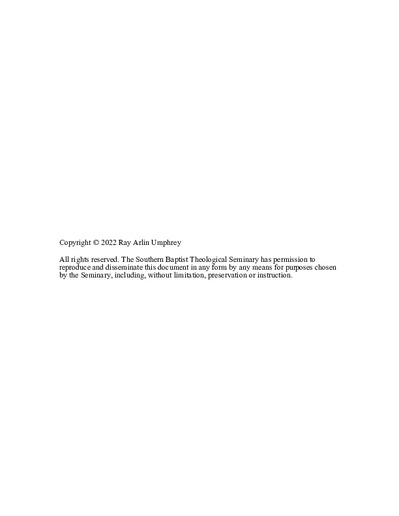| dc.contributor.advisor | York, Hershael W. | |
| dc.contributor.author | Umphrey, Ray Arlin | |
| dc.date.accessioned | 2023-01-03T21:04:47Z | |
| dc.date.available | 2023-01-03T21:04:47Z | |
| dc.date.issued | 2022-12-02 | |
| dc.identifier.uri | https://hdl.handle.net/10392/6975 | |
| dc.description.abstract | For centuries, the Sermon on the Mount has received particular attention as a discrete unit of Christ’s teaching, yet disagreement reigns among its interpreters. A central concern among the Sermon’s interpreters is the question of structure. While general agreement exists concerning the overall macrostructure of the Sermon, various proposals exist with differing understandings for the relationships and boundaries of certain pericopes. The most troublesome section is the third major section of the body in Matthew 6:19–7:11. While most scholars recognize the boundaries of this section as a legitimate division, no cohesive structure or theme is widely agreed upon.This dissertation seeks to solve the structural and thematic difficulties surrounding this section of the body of the Sermon on the Mount by applying discourse analysis to the Sermon, specifically the categories of structure, cohesion, prominence, and peak. I will argue that Matthew 6:19–7:11 is a cohesive unit of text consisting of four definable pericopes, which results in a peak construction with Matthew 6:31–33 functioning as the climax of the Sermon and 7:6–11 as a corresponding denouement. The theme of this section is best described as “Desiring the Kingdom” and functions within the Sermon to reveal the inner value system necessary for obedience to the Sermon.
Chapter one provides a summary of research and introduces the thesis. Chapter two explores the challenges and benefits of discourse analysis and specifies the methodology employed in this dissertation. Chapter three surveys the macrostructure of the Sermon on the Mount and provides a textual outline for the Sermon. Chapter four analyzes the microstructures of the Sermon in greater detail to demonstrate patterns of prominence and cohesion. Chapter five is an argument for the unity of Matthew 7:6–11. Chapter six provides a detailed analysis of Matthew 6:19–7:11 with particular focus on Matthew 6:31–33 and 7:6–11 which are identified as the peaks of the Sermon. Chapter seven explores the homiletic implications and benefits of discourse analysis as well as the homiletic implications of the preceding analysis of the Sermon. Chapter eight summarizes the research and provides suggestions for future research. | en_US |
| dc.subject.lcsh | Bible. Matthew VI, 19-VII,11 Criticism, interpretation, etc. | en_US |
| dc.subject.lcsh | Sermon on the mount--Criticism, interpretation, etc. | en_US |
| dc.title | The Cohesive Rhetoric of Jesus: The Role of Matthew 6:19–7:11 in the Sermon on the Mount | en_US |
| dc.type | Electronic dissertation | en_US |
| dc.type | Text | |
| dc.contributor.committee | Pennington, Jonathan T. | |
| dc.contributor.committee | Plummer, Robert L. | |
| dc.type.qualificationname | Ph.D. | en_US |
| dc.publisher.institution | Southern Baptist Theological Seminary | en_US |
| dc.publisher.department | School of Theology | |

